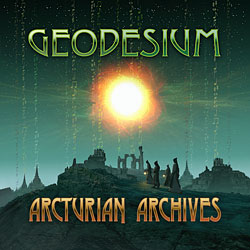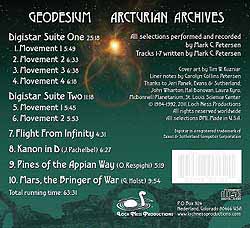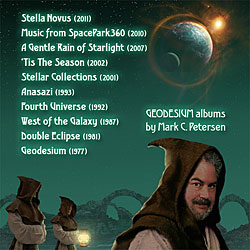GEODESIUM Arcturian Archives
Digistar Suite One 25:181. Movement 1 5:49
2. Movement 2 6:33
3. Movement 3 6:38
4. Movement 4 6:18
Digistar Suite Two 11:18
5. Movement 1 5:45
6. Movement 2 5:53
7. Flight From Infinity 4:31
8. Kanon in D (J. Pachelbel) 6:27
9. Pines of the Appian Way (O. Respighi) 5:19
10. Mars, the Bringer of War (G. Holst) 9:54
Total running time: 63:31
All selections performed and recorded by Mark C. Petersen
Tracks 1-7 written by Mark C. Petersen
Album art by Tim W. Kuzniar
Liner notes by Carolyn Collins Petersen
Thanks to Jeri Panek, Evans & Sutherland;
John Wharton, Hal Donovan, Laura Kyro, McDonnell Planetarium, St. Louis Science Center
Digistar is a registered trademark of Evans & Sutherland Computer Corporation
© 1984-1992, 2011, Loch Ness Productions. All rights reserved worldwide. All selections BMI.
Arcturian Archives takes listeners back to an exciting time in the development of technology — the digitalization of both the planetarium projector itself and the musical keyboards which created the space music of the time. Mark has always been on the forefront of planetarium show production using new technology. This is an album of music originally created to accompany those times of technological revolution.
The two Digistar Suites on this album were originally created for Evans & Sutherland to accompany demonstration programs of their pioneering planetarium projector system. Digistar was the world's first digital planetarium projector system. Introduced in the early 1980s, it took the planetarium world by storm. Instead of a mechanical "star ball" mechanism in the middle of the theater, Digistar was instead a high-powered CRT tube with an overtly large fisheye lens on it to project computer graphics on the dome. No longer was the planetarium limited to showing stars from an Earth-based perspective; for the first time, audiences could experience flying through the solar system and out to the stars. Its monochrome stars and wireframe models were simplistic by today's standards, though they pushed the limits of the available computing power at the time. Still, the technology pioneered by Digistar was a major advance in the field, and it liberated producers and planetarians in their programming philosophies.
For this album, the two Digistar Suites have been divided into separate tracks, though each suite was originally a single, continuous work without pauses between the movements. The first was recorded in 1989; the second in 1992. Early versions of the first suite actually had a narrator describing what the visuals were, crediting who had created them, and offering a bit of a sales pitch. In the second suite, only the music accompanied the visuals. We provide descriptions below of the visuals the audiences would experience.
Mark created the music by watching a reference videocassette that had captured the Digistar's visual output as a fisheye projection in a flat-screen circle. The timings for all the scenes and events had already been programmed by E&S; Mark had to make the music hit points match. For the most part, the music was newly composed just for the programs. A few selections began as tracks from our MUSIC BACK-PACK Library, which were then customized and augmented for the shows.
Digistar Suite One
Movement 1 begins with the view inside an observatory dome; "motors" grind to open the doors of the slit, revealing the starry night sky. We lift off and fly through the slit into the stars; then the stars morph into the word "Digistar". The word explodes to form a new starfield, which then folds into a mathematical model of a Sierpinski triangle that we fly into and around.
We then proceed through a series of computer models: a DNA molecule; the atoms of a busy water molecule in motion; a stately Dutch windmill; then we fly up the Euromast and burst through the top; finally an architectural model of the pretty countryside around a hydroelectric dam project.
Movement 2 accompanied a demonstration of the astronomical features of a digital planetarium: showing how a 3-D cursor can indicate stars, a comet tail elongating, celestial proper motion, and the usual grids to mark precession, the galactic equator, the ecliptic, and such.
The visuals at the end of this movement had the visible stars in the sky morphing into they way they'd look in other "invisible" wavelengths — radio, gamma ray, x-ray, and radio.
Movement 3 gives us the sound of a space shuttle launch, which audiences see as it climbs from the pad, sets the solid rocket boosters and external tank adrift, then arrives in Earth orbit. The payload bay doors open, and the Hubble Space Telescope is deployed.
In an overwhelming entrance, the International Space Station rises into view, and we fly with the shuttle to dock with it, then do a glamour pass around the pair. We then leave the Earth behind and fly around the orbital paths of all the planets.
Movement 4 features music accompanying more flights through mathematical models. First, a tetrahedral fractal; then, the "infinity" cube of dots; into a spiraling nautilus shell; then, around a Lorenz attractor. Finally, we are pulled into a gravity well and down a seemingly endless tunnel into the depths of a black hole, which explodes into an alternate universe to end the presentation and roll into credits.
Digistar Suite Two was created in 1992, to premiere at the International Planetarium Society conference in Salt Lake City, home town of E&S. The company's demo had a general theme of "imagination"; no sales pitch or narration this time, just some inspiring visuals and music.
Movement 1 begins with an "imagination" orb which appeared at open and close, and the same sort of fanfare as the first suite, to introduce the word "Digistar". The first scenic visualization flies us around the fleet of Columbus's ships on the high seas. Then we fly over a landscape grid; perhaps the ships have found the New World. We then get small, zooming into the soil to see flowers growing up the dome before our eyes; we follow dandelion seeds drifting away on the wind.
Movement 2 takes audiences on a flight to the stars of Orion yet again. There a crystalline entity appears, which morphs into other fractal crystals. Then audiences get pulled into a wormhole, which turns into a wild roller-coaster ride around on a Möbius strip and in a Klein bottle. The imagination orb reappears at the end, to return everyone to reality.
Flight From Infinity is the finale and credits music from the show Gateway To Infinity, created in 1985 for the St. Louis Science Center's McDonnell Planetarium.
The uptempo portion accompanied a dizzying Digistar flight through an architectural wire-frame model of the entire downtown area of St. Louis, around Busch Stadium, up and through the tallest skyscraper in the city, and finally ending the show at the distinctive paraboloid-shaped building of the planetarium. The stately cello trio is a more fully embellished version of the Milky Way Galaxy section of the show, featured in the foreground as the credits music.
Pachelbel's Kanon in D had made its first appearance on the Geodesium LP Double Eclipse, an all-EMS Synthi version from 1977. Seven years later, Mark re-created it using the Emulator II, recorded with some original instrumental sounds in addition to E-mu's orchestral samples.
Pines of the Appian Way was created in a fit of pique. In 1984, the St. Louis Science Center commissioned Loch Ness Productions to create a show called Gateway to Infinity. Their theater had undergone major renovation, and this show would be a grand re-opening premiere.
During initial project discussions, St. Louis's show producer Hal Donovan seemed rather dismissive of Mark's proposed synthesizer-based approach to the soundtrack, with the comment that synths sounded "thin". Mark set out to prove otherwise. This 107-track version of Ottorino Resphighi's Pines of the Appian Way was impressive enough to win Mark the soundtrack contract.
1988 was the year of Mars. Solar system-wise, the red planet was at perihelic opposition — the point where both Earth and Mars were as close as their elliptical orbits allow — so it was bright and prominent in the night sky. Loch Ness Productions had just introduced its first major planetarium show package called The Mars Show. With narration by Patrick Stewart, the "new" captain of the Enterprise on the "new" Star Trek: The Next Generation TV series, it eventually became one of our most popular offerings. We were premiering our new show at another conference of the International Planetarium Society, a biennial meeting we usually attended. At our trade show booth in the vendor hall, we gave away candy — Mars bars, of course.
And the musicians of the Celestial Rhythms trio (Mark, Jonn Serrie and Barry Hayes) were on the conference program to give a rare live concert performance. So of course, the choice of Gustav Holst's Mars, the Bringer of War to conclude the show was the obvious one.





